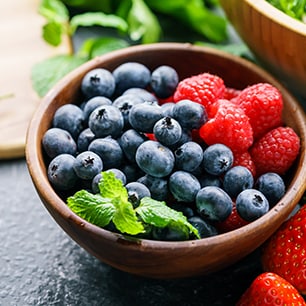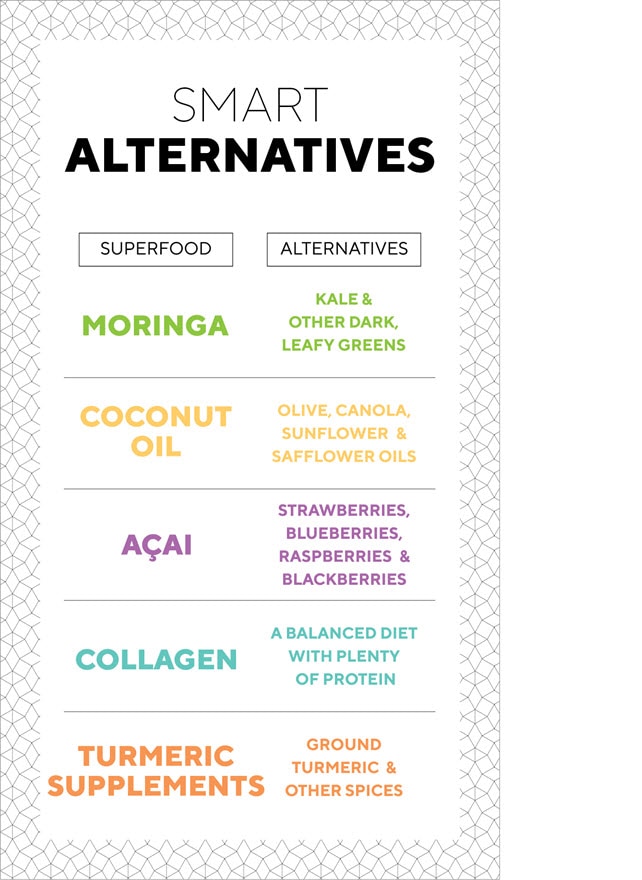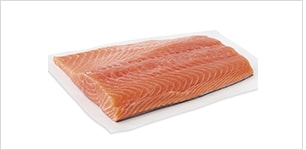How super are superfoods? Do they make your skin healthier or bones stronger? Are they better than foods you already eat? The truth is that the term superfood has no official scientific definition, yet many products known as superfoods claim to cure everything from heart disease to gastrointestinal issues to chronic pain.
It’s time to debunk the myths surrounding five common superfoods. Let’s uncover the truth and discover some readily available alternative food choices that offer health benefits as part of a balanced eating plan.

Superfood Myth 1
Moringa can help treat diabetes, protect eyes, improve cardiovascular health, enhance bone health, speed wound healing, and boost skin health.1
Facts: None of these claims have been proven. Moringa is a fast-growing softwood tree indigenous to sub-Himalayan tracts of Northern India. Its leaves are the most nutritious part of the tree. Most often, moringa is consumed as a powder in supplements rather than as a whole food. Drying and powdering a food concentrates the nutrients.
The nutritional profile of moringa looks impressive, but typically the dried powder is compared to equal weights of whole foods. When comparing fresh moringa leaves to kale, the nutritional profile of moringa leaves is not as impressive as that of kale.
Alternatives: Kale and other dark, leafy greens, though not proven to be curative, have beneficial vitamins and nutrients.
Nutrient Comparison: One cup of moringa has 10.9 milligrams vitamin C and 0.4 grams fiber. Its fresh leaves have small amounts of potassium, calcium, and vitamin A.2 One cup of raw kale has
19.6 milligrams vitamin C, 81.8 micrograms vitamin K, and 0.9 grams fiber.
Bottom Line: Kale and other dark, leafy greens are more nutrient-dense than moringa leaves when compared in the whole state—plus, you can easily find them when you’re shopping for groceries.
Superfood Myth 2
Coconut oil is heart-healthy, burns belly fat, revs up your metabolism, helps prevent Alzheimer’s, and helps diabetics.3
Facts: Research touting the health claims of coconut oil remains inconclusive. Coconut oil is a saturated fat, and consuming too much saturated fat has been associated with raising LDL cholesterol, a cause of cardiovascular disease. The American Heart Association recommends against using coconut oil.4 It’s better to consume more unsaturated fats and reduce the amount of saturated fats.5
Alternatives: Olive, canola, sunflower, and safflower oils
Bottom Line: Reduce or avoid animal foods high in saturated fats, such as red meat, full-fat dairy products, and tropical oils, including coconut and palm oils. Opt for oils with more unsaturated fats, such as olive, canola, sunflower, and safflower oils. Find out more about the good fats.
Superfood Myth 3
Açai can help with arthritis, weight loss, high cholesterol, erectile dysfunction, skin appearance, detoxification, and general health.6
Facts: The açai berry is harvested from açai palm trees, native to South American rainforests. Transportation of these berries can be difficult because they are delicate. Açai is most often found in powder form as a capsule or an ingredient in a smoothie or juice. Like other berries, açai berries contain vitamins and fiber—and the proposed health benefits revolve around high levels of antioxidants and flavonoids. However, research on açai berries is limited, and the claims about their health benefits have not been proven.3
Bottom Line: Instead of seeking out exotic berries with uncertain benefits, pick up strawberries, blueberries, raspberries, or blackberries7 that contain fiber and vitamin C.
Superfood Myth 4
Collagen improves skin, hair, and nail appearance; helps eye health; protects against heart disease; enhances athletic performance; and strengthens bones.
Facts: The most abundant protein in our bodies, collagen is found in bones, skin, blood vessels, ligaments, and cartilage. It holds our cells and tissues together, giving connective tissue strength and elasticity. Our collagen production slows down as we age, resulting in wrinkles, joint pain, and other telltale signs of aging. Collagen supplements are booming in the United States in powders, pills, nutrition bars, and even bone broth.
It’s important to keep in mind that clinical studies on the role of collagen peptides in bone and joint health are limited, and there’s no evidence of the long-term effectiveness of collagen supplements. Some collagen products, including bovine collagen, have caused allergic reactions. Possible side effects to collagen supplements include nausea, heartburn, diarrhea, constipation, drowsiness, skin reactions, and headaches.8
Bottom Line: Rather than following an unproven trend, consider eating a balanced diet with plenty of protein.
Superfood Myth 5
Turmeric supplements can manage inflammation; arthritis; stomach, skin, liver, and gallbladder issues; cancer; and more.
Facts: Turmeric is a plant related to ginger that’s grown in India, other areas of Asia, and Central America. Historically, turmeric has been used in Ayurvedic medicine to treat breathing problems, rheumatism, pain, fatigue, and other conditions. Curcumin, which gives turmeric its characteristic yellow color, is believed to have anti-inflammatory properties. However, these claims are not supported by strong studies.9 Some experts believe that additional research is needed to improve absorption and determine specific recommendations for curcumin intake.10
Bottom Line: While current research does not prove the benefits of turmeric supplements, turmeric is a flavorful, colorful spice that you can add to recipes such as Indian curries and soups. Check out our GreenWise ground turmeric.

Foods with Benefits
Whole foods are better than supplements because they offer many beneficial nutrients that work together to aid in absorption. Rather than following superfood trends, look for foods with vitamins and minerals to include in your personalized eating plan. A wide variety of delicious alternatives to superfoods are readily available at your neighborhood Publix.
Berry Good
One cup of strawberries is a good source of fiber and folate, and an excellent source of vitamin C! March is strawberry season, so pick up some fresh ones. Or get them frozen any time of year. Try strawberries in these Publix Aprons® Better Choice recipes.
For breakfast:
Berry PB Protein Smoothies
Berry Oat Bake
For dinner:
Pecan-Berry Salmon with Orange Quinoa Salad
Penne Pasta Sauté and Baby Salad Greens with Strawberries
For dessert:
Strawberry Clouds with Vanilla Sauce
Bean Benefits
Beans and legumes—such as kidney beans, pinto beans, black beans, lima beans, black-eyed peas, garbanzo beans (chickpeas), split peas, and lentils—contain fiber, iron, and zinc.11 Look for the Better Choice shelf tags to identify options with less sodium. Find more bean benefits here.
These plant-based sources of protein make great additions to your weekly menu. Check out our Publix Aprons Better Choice recipes featuring beans and legumes.
For appetizers:
Chickpea-Quinoa Patties with Cucumber Sauce
Pinto Bruschetta
For dinner:
Lentil Burger with Cool Avocado Salsa
Hearty Potato and Lentil Salad
Green Up!
Dark, leafy greens contain fiber as well as other vitamins and minerals. Publix offers kale, spinach, arugula, collards, and Swiss chard in the Produce department. Kale is a good source of fiber, calcium, and folate, and an excellent source of vitamins A and K. Enjoy it in our Publix Aprons Kale and Farro Stew and our Southwest Pork and Rice Bowl recipes.
Smart Salmon
Salmon is a protein with great health benefits and is a flavorful way to get your 8 ounces of seafood per week, as recommended in the 2015–2020 Dietary Guidelines for Americans. At Publix, our seafood is sustainably and responsibly sourced—and you can find our salmon in both fresh and frozen varieties.
Just in time for St. Patrick’s Day, serve Salmon-Sausage Coddle, our hearty, Irish-inspired stew. Or try other Better Choice recipes featuring this distinctively tasty fish.
Seeds, Please
You’ve heard about nuts, but what about seeds? While exact nutrient compositions vary, seeds contain unsaturated fats, fiber, and vitamins and minerals. Chia seeds (3 tablespoons contain 5 grams protein and 12 grams fiber) are a good source of protein and an excellent source of fiber.12
Choose from a variety of seeds—such as chia, hemp, and flax—that are easy to incorporate into dishes for a boost of flavor, nutrition, and crunch. Sprinkle them in your oatmeal, smoothie, cereal, salad, rice, or baked goods. Our Publix Aprons Overnight Apple-Berry Oats recipe makes a great breakfast on the go.
Yogurt for You
A 6-ounce container of creamy, low-fat yogurt provides a good source of protein and an excellent source of calcium.13 Yogurt also delivers probiotics, helpful bacteria that may aid in maintaining a healthy gut. Certain yogurts and other cultured dairy products contain strains of bifidobacterium and lactobacillus.14 Learn more about the benefits of probiotics for digestive health.
Look for the Better Choice shelf tags at Publix to find yogurts with less saturated fat and added sugar. Plain yogurt is a versatile option—you can sweeten it naturally with fruits or use it in a variety of recipes, from sweet to savory. Here are a few yummy examples.
Sweet Dishes:
Peanut Butter-Banana Chia Pudding
Blueberry-Almond Smoothie Bowl
Savory Selections:
Poached Salmon with Yogurt Dill Sauce
Avocado Hummus
For the Love of You
Choosing how you eat is uniquely personal. It’s about your needs, your preferences, and your goals. As your wellness ally, Publix is in your corner with fresh ideas, recipes, and wellness icons that make it easier to shift toward wiser food choices. It’s all about you, at your very best.
Sources
1 Paikra, Birendra Kumar, Hemant Kumar J. Dhongade, and Bina Gidwani. "Phytochemistry and Pharmacology of Moringa oleifera Lam." Journal of Pharmacopuncture XX, no. III (September 2017): 194–200.
2 "Moringa." USDA Food Composition Databases. Accessed January 11, 2019.
3 Thalheimer, Judith C., RD, LDN. "Coconut Oil." Today's Dietitian 18, no. 10 (October 2016): 32.
4 "Saturated Fats: Why All the Hubbub over Coconuts?" American Heart Association. June 21, 2017.
5 U.S. Department of Health & Human Services (HHS). “A Closer Look Inside Healthy Eating Patterns.” 2015-2020 Dietary Guidelines for Americans, 8th ed. November 21, 2016.
6 Zeratsky, Katherine, RD, LD. "What Are Acai Berries, and What Are Their Possible Health Benefits?" Mayo Clinic. May 2, 2018.
7 “Strawberries.” “Blueberries.” “Raspberries.” “Blackberries.” USDA National Nutrient Database for Standard Reference. Accessed January 11, 2019.
8 Amidor, Toby, MS, RD, CDN. “Ask the Expert: Collagen Peptides for Bones and Joints.” Today’s Dietitian 19, no. 11 (November 2017): 10.
9 U.S. Department of Health & Human Services (HHS). "Turmeric." National Institutes of Health: National Center for Complementary & Integrative Health. September 2016.
10 Collison, Sharon, MS, RD, LDN, CSSD. “Curcumin and Inflammatory Diseases: Learn About Its Potential Role in Prevention and Treatment.” Today’s Dietitian 16, no. 9 (September 2014): 56.
11 United States Department of Agriculture (USDA). "Beans and Peas Are Unique Foods." ChooseMyPlate.gov. Accessed January 8, 2019.
12"Basic Report: Seeds, Chia Seeds, Dried." USDA Food Composition Databases: National Nutrient Database for Standard Reference Legacy Release. April 2018.
13 “Basic Report: Yogurt, Plain, Low Fat.” USDA Food Composition Databases: National Nutrient Database for Standard Reference Legacy Release. April 2018.
14 International Food Information Council Foundation. “Functional Foods Fact Sheet: Probiotics and Prebiotics.” Food Insight. May 23, 2014.

 You are about to leave publix.com and enter the Instacart site that they operate and control. Publix’s delivery and curbside pickup item prices are higher than item prices in physical store locations. Prices are based on data collected in store and are subject to delays and errors. Fees, tips & taxes may apply. Subject to terms & availability. Publix Liquors orders cannot be combined with grocery delivery. Drink Responsibly. Be 21. For prescription delivery, log in to your pharmacy account by using the Publix Pharmacy app or visiting
You are about to leave publix.com and enter the Instacart site that they operate and control. Publix’s delivery and curbside pickup item prices are higher than item prices in physical store locations. Prices are based on data collected in store and are subject to delays and errors. Fees, tips & taxes may apply. Subject to terms & availability. Publix Liquors orders cannot be combined with grocery delivery. Drink Responsibly. Be 21. For prescription delivery, log in to your pharmacy account by using the Publix Pharmacy app or visiting 
